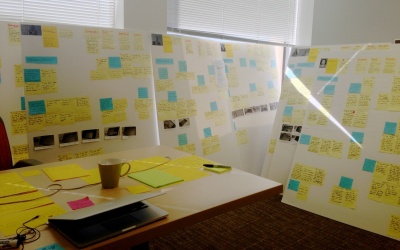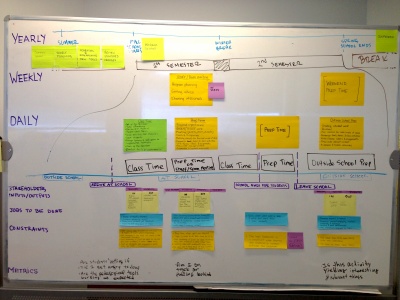Difference between revisions of "Products/Pasteboard/UserResearch"
(Created page with "= User Profile = = Methodology = = Insights, Themes, Workflows = = JTBD & Constraints = = fixme - previous text = In our user research, we gathered valuable information a...") |
|||
| Line 1: | Line 1: | ||
| − | = | + | = Methodology = |
| + | |||
| + | [[file:User_research_method.jpg|200px|thumb|right|Process overview]] | ||
| + | |||
| + | Roughly speaking: | ||
| + | # Develop user interview criteria and interview guide. | ||
| + | # Interviews and field research. Gather qualitative data. | ||
| + | # Develop themes and insights, followed by needs, constraints, and behaviors/tasks | ||
| + | # Develop ideas and opportunities, followed by prototypes | ||
| + | # Validate findings and prototypes | ||
| − | = | + | Of course, this process blends into the product creation cycle, it is not a static set of work. That is, the prototypes are initial product ideas, and form the basis of iterations which yield additional data, which we use to validate our data and learn more, which in turn leads to the next prototype, and so on. |
| + | |||
| + | = Goals = | ||
| + | |||
| + | Our research focus was to understand how k-12 teachers find, curate, and remix content for their classes and homework. | ||
| + | |||
| + | = Interviews = | ||
| + | |||
| + | We developed a rough criteria of the kinds of behaviors we expected to yield more insights, and used them to recruit a set of teachers: | ||
| + | |||
| + | • Tweaking and adapting their existing educational materials for their classes and student homework | ||
| + | • Finding new ways or tools for their students to learn | ||
| + | • Building experimental teaching resources | ||
| + | • Teaching classes without a textbook, or unsatisfied with the given textbook options | ||
| + | • Creating and conducting project-based learning classes | ||
| + | • Teaching multidisciplinary subject matters (ex. math and science) | ||
| + | • Creating homework that is adaptive to each student’s needs | ||
| + | • Teaching in foreign languages (e.g., Mandarin or Russian school in the US) | ||
| − | + | These were a starting point, and once we developed an initial interview guide, we scheduled user interviews. Some were in context (at a school), though not all. All of the teachers were in the San Francisco South Bay Area ("Silicon Valley"). | |
| − | + | (todo: more info on interviews here) | |
| − | = | + | = Themes & Insights = |
| − | + | We gathered a lot of data: | |
[[file:Teacher_Research.jpg|400px|thumb|left|Teacher Research]] | [[file:Teacher_Research.jpg|400px|thumb|left|Teacher Research]] | ||
<br clear="all"><br> | <br clear="all"><br> | ||
| − | While we realize that these teachers do not represent the needs of all teachers everywhere, we | + | While we realize that these teachers do not represent the needs of all teachers everywhere (given our Silicon Valley focus), we did gather some very interesting insights which allow us to begin with these teacher communities before expanding to others. Here are top-level insights we learned (from the POV of the teacher): |
* No matter where it comes from, I always have to adapt content, but it is hard, so I don't always do it. | * No matter where it comes from, I always have to adapt content, but it is hard, so I don't always do it. | ||
| Line 27: | Line 53: | ||
* Staying on top of plans and dealing with multiple classrooms and limited class time is challenging. | * Staying on top of plans and dealing with multiple classrooms and limited class time is challenging. | ||
* I have a strong sense of right and wrong, but the legal framework doesn't match that. | * I have a strong sense of right and wrong, but the legal framework doesn't match that. | ||
| − | + | ||
| + | = Behaviors & Tasks = | ||
Here's a snapshot of what a day/week/year looks like, at a very high level: | Here's a snapshot of what a day/week/year looks like, at a very high level: | ||
| − | [[file:Teacher_Research_Day.jpg|400px|thumb|left|Teacher | + | [[file:Teacher_Research_Day.jpg|400px|thumb|left|Teacher Journey]] |
<br clear="all"><br> | <br clear="all"><br> | ||
| + | |||
| + | = JTBD & Constraints = | ||
Revision as of 19:19, 5 September 2013
Contents
Methodology
Roughly speaking:
- Develop user interview criteria and interview guide.
- Interviews and field research. Gather qualitative data.
- Develop themes and insights, followed by needs, constraints, and behaviors/tasks
- Develop ideas and opportunities, followed by prototypes
- Validate findings and prototypes
Of course, this process blends into the product creation cycle, it is not a static set of work. That is, the prototypes are initial product ideas, and form the basis of iterations which yield additional data, which we use to validate our data and learn more, which in turn leads to the next prototype, and so on.
Goals
Our research focus was to understand how k-12 teachers find, curate, and remix content for their classes and homework.
Interviews
We developed a rough criteria of the kinds of behaviors we expected to yield more insights, and used them to recruit a set of teachers:
• Tweaking and adapting their existing educational materials for their classes and student homework • Finding new ways or tools for their students to learn • Building experimental teaching resources • Teaching classes without a textbook, or unsatisfied with the given textbook options • Creating and conducting project-based learning classes • Teaching multidisciplinary subject matters (ex. math and science) • Creating homework that is adaptive to each student’s needs • Teaching in foreign languages (e.g., Mandarin or Russian school in the US)
These were a starting point, and once we developed an initial interview guide, we scheduled user interviews. Some were in context (at a school), though not all. All of the teachers were in the San Francisco South Bay Area ("Silicon Valley").
(todo: more info on interviews here)
Themes & Insights
We gathered a lot of data:
While we realize that these teachers do not represent the needs of all teachers everywhere (given our Silicon Valley focus), we did gather some very interesting insights which allow us to begin with these teacher communities before expanding to others. Here are top-level insights we learned (from the POV of the teacher):
- No matter where it comes from, I always have to adapt content, but it is hard, so I don't always do it.
- A 'successful day' is based on the feedback that I get regarding the expectations I have for my students and for myself.
- Prepping is an intense planning and customization activity subject to many external pressures like moving schedules, changing standards, and team changes.
- Differentiation allows me to engage students at varied levels or interests, but it requires extra effort, immediate feedback, and deep subject expertise.
- I consider the textbook to be just an outline, so I'm always looking for new, relevant content, even though it takes a lot of time.
- I recognize creation and curation as both forms of ownership, but neither stops me from sharing with my colleagues.
- I complement my teaching with additional materials, but it's hard to control the exact experience and learning path.
- Tool lock-in is a worry, but if it's clear how it will fit my workflow from the start I might use it.
- Not all kids learn in the same way, so I like to mix things up to keep myself and the kids engaged.
- Staying on top of plans and dealing with multiple classrooms and limited class time is challenging.
- I have a strong sense of right and wrong, but the legal framework doesn't match that.
Behaviors & Tasks
Here's a snapshot of what a day/week/year looks like, at a very high level:

